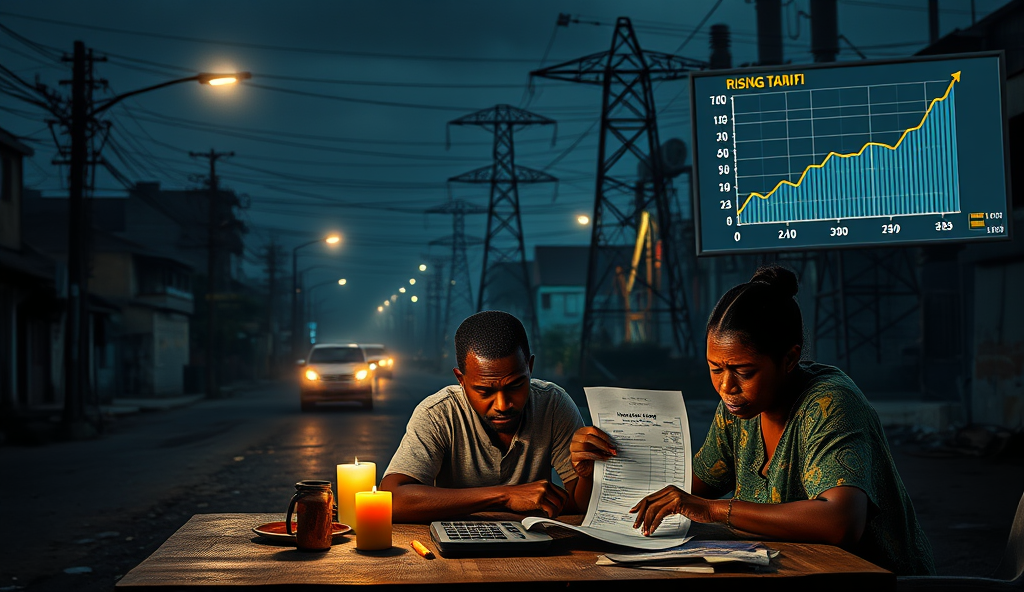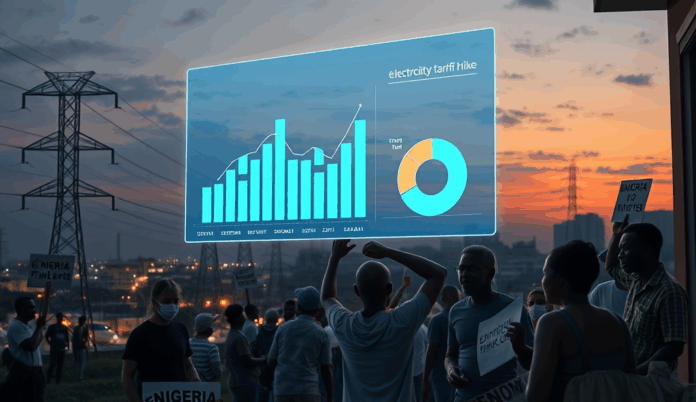Introduction to Electricity Tariff Hike in Nigeria
The recent electricity tariff hike in Nigeria, implemented by the Nigerian Electricity Regulatory Commission (NERC), has sparked widespread discussions among consumers and businesses. This adjustment, which took effect in April 2024, reflects the government’s efforts to phase out subsidies and align power costs with market realities, following years of underinvestment in the sector.
For instance, Band A customers now face a 240% increase, paying ₦225 per kWh compared to the previous ₦66, while lower bands experience varying adjustments. These changes aim to improve power supply by enabling distribution companies to invest in infrastructure, though they place immediate financial pressure on households and SMEs.
Understanding these new rates requires examining the tariff structure, which we’ll explore next, including how different consumer categories are affected and practical ways to manage the increased costs. The subsequent section will break down the calculations and band classifications to help Nigerians navigate this transition.
Key Statistics

Understanding the New Electricity Tariff Structure
The recent electricity tariff hike in Nigeria implemented by the Nigerian Electricity Regulatory Commission (NERC) has sparked widespread discussions among consumers and businesses.
The revised tariff structure categorizes consumers into bands (A-E) based on daily power supply hours, with Band A receiving 20+ hours and Band E getting less than 4 hours. For example, Lagos businesses in Band A now pay ₦225/kWh, while rural households in Band E face ₦50/kWh, reflecting NERC’s targeted approach to cost recovery.
Each band’s pricing considers infrastructure quality and service reliability, with urban areas typically falling into higher bands due to better grid maintenance. DisCos like Ikeja Electric and Eko Electricity Distribution Company apply these rates differently based on localized consumption patterns and operational costs.
Understanding your band classification is crucial for accurate billing, as the new structure directly ties costs to service levels. Next, we’ll examine the economic and policy factors driving this tariff increase, including subsidy removal and sector investments.
Factors Influencing the Recent Tariff Increase
Band A customers now face a 240% increase paying ₦225 per kWh compared to the previous ₦66 while lower bands experience varying adjustments.
The Nigerian Electricity Regulatory Commission (NERC) cites rising generation costs and infrastructure investments as primary drivers behind the tariff hike, with gas prices increasing by over 300% since 2022. Government subsidy removal, which previously covered 60% of electricity costs, now shifts this financial burden to consumers through the new banded pricing system.
Urban centers like Lagos and Abuja face steeper increases due to higher service reliability, with DisCos investing ₦2.3 trillion in grid upgrades since 2023. This aligns with the band-based structure discussed earlier, where improved infrastructure justifies higher tariffs for consistent power supply.
These changes aim to attract private sector investments while reducing government expenditure, though critics argue low-income households bear disproportionate impacts. Next, we’ll break down how these factors translate into actual billing calculations under the new system.
Step-by-Step Guide to Calculating Your New Electricity Bill
The revised tariff structure categorizes consumers into bands (A-E) based on daily power supply hours with Band A receiving 20+ hours and Band E getting less than 4 hours.
First, identify your tariff band (A-E) based on your location and average daily supply hours, as DisCos now charge ₦225/kWh for Band A (20+ hours) versus ₦68/kWh for Band E (<4 hours). Multiply your kWh consumption (from meter readings) by the applicable rate, then add the fixed monthly service fee (₦1,050 for single-phase meters in Lagos).
For example, a Band A customer using 300kWh monthly pays (300 × ₦225) + ₦1,050 = ₦68,550, compared to ₦21,450 under previous rates. Remember that VAT (7.5%) and other statutory charges may apply depending on your DisCo’s billing structure.
Accurate calculations require verifying both your consumption data and current tariff band, which we’ll explore next through proper meter reading techniques. This ensures you’re billed correctly under Nigeria’s reformed power sector pricing model.
How to Read Your Electricity Meter for Accurate Billing
Government subsidy removal which previously covered 60% of electricity costs now shifts this financial burden to consumers through the new banded pricing system.
To verify your kWh consumption under Nigeria’s new tariff structure, start by recording the current numbers displayed on your meter, subtracting the previous reading (found on your last bill). For digital meters, note the displayed kWh value, while analog meters require reading the dials from right to left, ignoring the red-marked dial for decimal points.
For example, if your meter shows 50250 kWh this month versus 49800 kWh last month, your consumption is 450kWh (50250 – 49800), which you’ll multiply by your band’s rate. Lagos customers using prepaid meters can check consumption via the “Energy Used” function by pressing the display button repeatedly until it appears.
Accurate readings prevent billing disputes and help track usage patterns, which we’ll analyze next when examining how the tariff hike impacts different consumer categories. Always cross-check with your DisCo’s billing cycle to align readings with their calculation periods.
Impact of the Tariff Hike on Different Consumer Categories
The new electricity tariff structure disproportionately affects residential consumers using over 450kWh monthly now paying N225/kWh compared to N68/kWh previously.
The new electricity tariff structure disproportionately affects residential consumers using over 450kWh monthly, now paying N225/kWh compared to N68/kWh previously, while Band A commercial users face 240% increases. Small businesses like Lagos barber shops report 35% operational cost spikes, forcing price adjustments or reduced operating hours to manage the Nigeria power sector reforms.
Low-income households consuming below 50kWh benefit from frozen rates, but middle-class families in Abuja and Port Harcourt struggle as air conditioning and appliance usage pushes them into higher bands. NERC new electricity rates reveal 60% of urban consumers now fall into Band B (N110/kWh), creating widespread financial strain across Nigerian cities.
Industrial users face complex impacts, with manufacturers reporting 18-25% production cost increases despite partial subsidies, prompting some to explore alternative energy solutions in Nigeria. These consumption patterns directly influence the practical strategies we’ll explore next for reducing electricity bills amid the tariff hike.
Tips to Reduce Your Electricity Consumption and Save Money
Given the financial strain caused by Nigeria’s new electricity tariff bands, households can optimize energy use by replacing old appliances with energy-efficient models, which reduce consumption by 30-50% according to NERC data. Middle-class families in Lagos and Abuja should limit air conditioner usage to peak hours and switch to inverter models, potentially saving N15,000 monthly on Band B tariffs.
Small businesses like Enugu restaurants can cut costs by installing motion-sensor lighting and scheduling high-energy equipment like refrigerators during off-peak periods, aligning with Nigeria power sector reforms. Commercial users facing 240% increases should conduct energy audits, as manufacturers report 20% savings from identifying phantom loads and optimizing production schedules.
For urban consumers now paying N110/kWh in Band B, adopting solar-powered security lights and smart power strips can prevent unnecessary consumption spikes that push households into higher tariff brackets. These practical measures create a natural transition to examining government policies shaping these electricity cost structures.
Government Policies and Regulations on Electricity Tariffs
The Nigerian Electricity Regulatory Commission (NERC) introduced the new tariff bands under the Multi-Year Tariff Order (MYTO) 2024, aiming to phase out subsidies and attract $2.8 billion annual investments into the power sector. Band A consumers now pay N225/kWh for 20+ hours of daily supply, while Band B faces N110/kWh, reflecting cost-reflective pricing mandated by the Electricity Act 2023.
These Nigeria power sector reforms align with World Bank recommendations to reduce government expenditure on electricity subsidies, which previously consumed N540 billion annually. However, the 240% tariff hike for commercial users has sparked debates about equitable implementation, especially for SMEs already grappling with high operational costs.
As consumers adapt to these changes through energy audits and solar alternatives, understanding NERC’s regulatory framework becomes crucial for navigating the new pricing structure, leading to common questions about tariff calculations.
Frequently Asked Questions About the New Electricity Tariff
Many consumers wonder how NERC determines tariff bands, with Band A’s N225/kWh rate calculated based on infrastructure investments and 20+ daily supply hours, while Band B’s N110/kWh reflects lower service reliability. The MYTO 2024 formula considers exchange rates, inflation, and gas prices, explaining why tariffs vary across regions like Lagos versus Kano.
Businesses question the 240% increase’s impact, as a Lagos bakery now spends N450,000 monthly on power versus N132,000 previously, forcing energy audits or solar adoption. NERC clarifies that commercial users subsidized residential rates for years, but the Electricity Act 2023 mandates cost-reflective pricing to attract $2.8 billion investments.
Residents ask if tariffs will reduce with improved supply, but NERC confirms rates are fixed for 2024 unless macroeconomic indices shift significantly. As debates continue, understanding these calculations helps consumers plan budgets while awaiting sector improvements promised by Nigeria’s power sector reforms.
Conclusion and Final Thoughts on the Electricity Tariff Hike
The recent electricity tariff hike in Nigeria reflects broader power sector reforms aimed at improving infrastructure, though it places immediate financial strain on households. With Band A consumers now paying ₦225 per kWh, many Nigerians must reassess their energy consumption patterns to manage costs effectively.
Alternative solutions like solar investments or energy-efficient appliances can help mitigate the impact of rising tariffs, as seen in Lagos households adopting prepaid meters. While the government justifies the increase as necessary for sector sustainability, public discontent highlights the need for balanced policy implementation.
Moving forward, transparent communication from NERC and phased implementation could ease the transition for consumers. The long-term success of these reforms depends on visible service improvements alongside fair pricing structures across all tariff bands.
Frequently Asked Questions
How can I check which tariff band my household falls under?
Contact your local DisCo office or check their website with your meter number to confirm your band classification based on daily supply hours.
What practical steps can small businesses take to cope with the 240% tariff increase?
Conduct an energy audit and shift high-power equipment usage to off-peak hours; consider installing solar panels for partial energy independence.
Are there any government relief programs for low-income households affected by the tariff hike?
The federal government has frozen tariffs for consumers using under 50kWh monthly; verify eligibility through your DisCo's customer service portal.
How accurate are the estimated billing calculations under the new tariff structure?
Always cross-check your meter readings monthly and report discrepancies immediately to avoid overbilling under the new band system.
Will switching to prepaid meters help manage costs under the increased tariffs?
Yes prepaid meters allow real-time consumption tracking and budgeting; request installation through your DisCo's online application platform.


